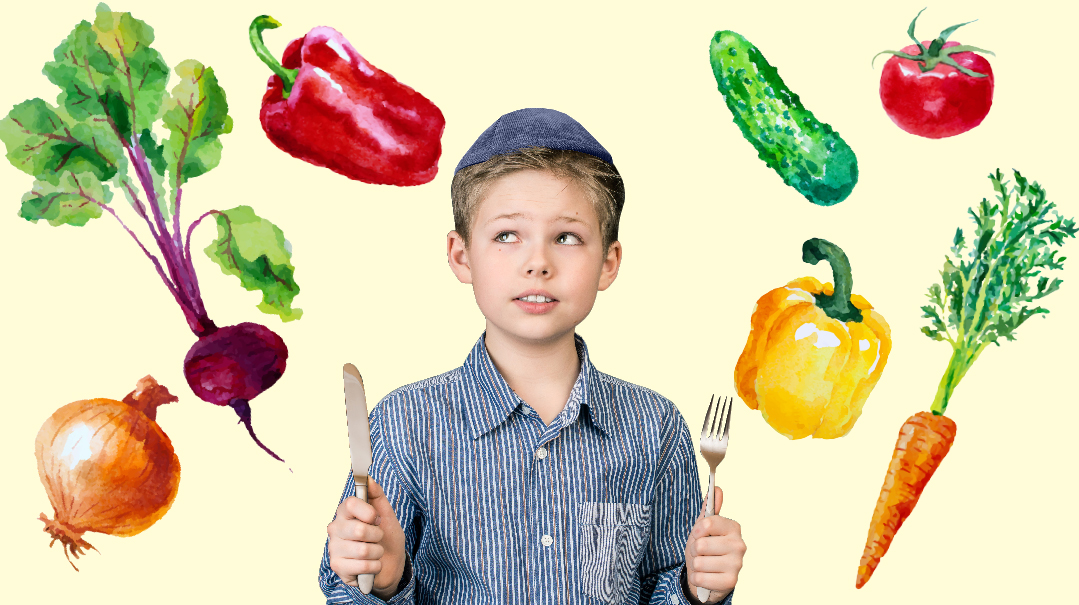The Great Veggie Experiment
| June 29, 2021One desperate mom’s quest to get her kids to eat more veggies

Of all the things I feel mommy guilt about, my children’s vegetable intake is pretty low on the list. I’ve tried over the years, cycling through many phases including: This Looks Like a Promising Strategy; Maybe They Won’t Notice This in the Food; and most frequently, That Was a Lot of Work for Little Reward.
Twelve years into parenting, the feeling I most associate with my kids and vegetables is hopelessness. Now I choose to focus on our strengths. We’re great at fruits. Unparalleled at carb consumption.
The first time I realized that not every child’s eating habits are created equal was one Shabbos when my oldest was a toddler. We were spending the long afternoon at a friend’s house. As we sat around the table, I looked on in astonishment as my friend’s toddler, around the same age as my oldest, ate a full plate of salmon, vegetables, and rice that wasn’t just plain white —essentially a whole adult meal.
My child was eating Cheerios. I made some comment on the difference between our children’s food preferences, and my friend’s husband told me that if I’d just put a variety of food in front of my child, my child would eat it.
Even now, I can still feel the sinking sensation I experienced when I heard that if I’d only make more of an effort, things would be different. In front of my child, that meal would’ve remained untouched. Hence the Cheerios diet and my decision to relegate vegetable intake to the “battles that aren’t worth fighting” category.
Recently though, a healthcare professional went into excruciating detail about how crucial it is for my children, aged two through twelve, to get the appropriate amount of nutrients from vegetables because of their huge impact on brain development. My dormant mommy guilt rocketed right up to the “I’m completely failing my children” level.
So when Family First asked if I’d be interested in trying to get my children to eat more vegetables and then write up the results, I was all for it. Taking on something like this as a fun project is much less terrifying than doing it because of the pressure of parental responsibility!
Information Gathering
To start, I put the question of how to increase my children’s vegetable intake out there on social media. Answers came pouring in. People apparently love to talk about their strategies and their successes — or lack thereof.
There were some suggestions that I liked but weren’t relevant for this article, such as growing our own vegetables (not enough time to do that), start the good eating habits when they’re babies (that ship has sailed), or to simply keep junk out of the house (I don’t want a full-scale revolt, thank you very much).
And then there were some validating responses from what I consider my kind of people: “Tried everything. I’ve officially surrendered,” and “Does M&M yogurt count as a health food?”
Still, there was a sizable number of responses that were just right. They fell into the following categories:
1.Trickery — hiding the vegetables in sauces or baked goods
2.Exposure — having vegetables frequently available
3.Modeling — eating vegetables myself, in front of my kids
4.Involvement — having the kids help prepare the dinner or plan the menu
These were all strategies I’d tried (and abandoned) over the years, but approaching them from a new and hopefully less emotionally charged perspective was surprisingly appealing.
As for my emotions, something I hadn’t anticipated about this information-gathering stage was how deeply I’d been affected by reading about other people’s successes. Apparently, my mommy guilt on this issue is alive and well, just buried under layers of other things to worry about, like screen-time allowance.
Oops! We could not locate your form.












